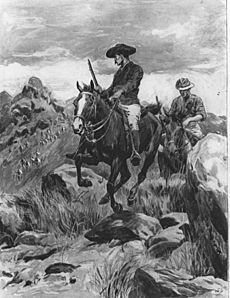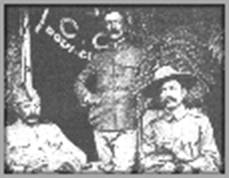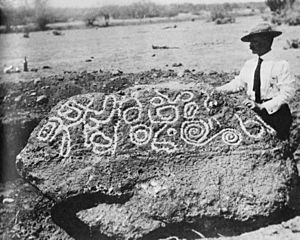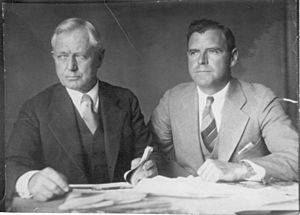Frederick Russell Burnham facts for kids
Quick facts for kids
Frederick Russell Burnham
DSO
|
|
|---|---|
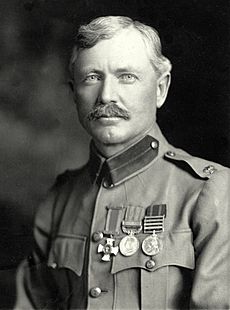
Major Burnham in his British Army uniform in 1901
|
|
| Nickname(s) |
|
| Born | May 11, 1861 Tivoli, Minnesota (Sioux Indian territory; near Mankato, Minnesota) |
| Died | September 1, 1947 (aged 86) Santa Barbara, California |
| Buried |
Three Rivers, California
(36°25′18″N 118°54′17″W / 36.4218°N 118.9047°W) |
| Allegiance | U.S. citizen; scout for the United States Army, and for the British South Africa Company and British Army in southern Africa |
| Years of service |
|
| Rank | Major |
| Commands held | Chief of Scouts under Lord Roberts |
| Battles/wars |
|
| Awards |
|
| Spouse(s) |
|
| Relations |
|
| Other work | Messenger, Indian tracker, cowboy, gold miner, oil man, U.S. spy. Father of the international Scouting movement, Honorary President of the Roosevelt Council (Arizona) Boy Scouts of America |
Frederick Russell Burnham (May 11, 1861 – September 1, 1947) was an American scout and adventurer. He was known for his work with the British Army in colonial Africa. He also taught outdoor skills to Robert Baden-Powell. This helped inspire the creation of the international Scouting Movement.
Burnham was born on a Dakota Sioux Indian reservation in Minnesota. As a boy, he learned the ways of American Indians. By age 14, he was supporting himself in California. He learned scouting from cowboys and frontiersmen in the American Southwest. Burnham did not have much formal education. He never finished high school.
In the early 1880s, he moved to the Arizona Territory. He became involved in the Pleasant Valley War, a conflict between ranching families. He escaped and later worked as a tracker for the United States Army in the Apache Wars. Wanting new adventures, Burnham took his family to southern Africa in 1893. He saw Cecil Rhodes's Cape to Cairo Railway project as a new frontier.
Burnham showed great bravery in battles in Rhodesia and South Africa. He became Chief of Scouts. Even though he was a U.S. citizen, King Edward VII formally made him a British major. For his bravery, the King gave him the Distinguished Service Order. This was the highest military honor an American earned in the Second Boer War. He became friends with Baden-Powell during the Second Matabele War. He taught Baden-Powell outdoor skills, which inspired Scouting. Burnham later returned to the United States. He worked in national defense, business, oil, and conservation. He also helped the Boy Scouts of America (BSA).
During World War I, Burnham was chosen to recruit volunteers for a U.S. Army division. Theodore Roosevelt planned to lead this group in France. However, the unit was disbanded before seeing action. After the war, Burnham and his business partner John Hays Hammond formed the Burnham Exploration Company. They became wealthy from oil found in California. Burnham joined several new wilderness conservation groups. This included the California State Parks Commission. In the 1930s, he worked with the BSA to save the bighorn sheep. This led to the creation of the Kofa and Cabeza Prieta National Wildlife Refuges in Arizona. He received the BSA's highest honor, the Silver Buffalo Award, in 1936. He remained active in Scouting until his death in 1947. In 1951, Mount Burnham in California was named after him. This honored his friendship with Baden-Powell, who also had a mountain named after him nearby.
Contents
Early Life and Adventures

Frederick Burnham was born on May 11, 1861, in Minnesota. His family were missionaries living near Tivoli, on a Dakota Sioux reservation. His father, Reverend Edwin Otway Burnham, was a Presbyterian minister. His mother, Rebecca Russell Burnham, was from England. During the Dakota War of 1862, Sioux warriors attacked a nearby town. Burnham's mother hid baby Frederick in a basket of corn husks. She fled for her life. When she returned, their house was burned, but Frederick was safe.
The young Burnham went to school in Iowa. There he met Blanche Blick, his future wife. In 1870, his family moved to California. His father was injured and died two years later. Burnham's mother and younger brother returned to Iowa. The 12-year-old Burnham stayed in California alone. He worked to support himself.
For several years, Burnham worked as a messenger for the Western Union Telegraph Company. He rode horses through California and Arizona Territory. At 14, he became a scout and tracker in the Apache Wars. He joined the United States Army to find the Apache chief Geronimo. In Prescott, Arizona, he met an old scout named Lee. Lee taught Burnham how to track Apache by smelling burning mescal. Burnham also learned from Al Sieber, the Chief of Scouts. He learned that a scout must know the history, traditions, and customs of the people he works among.
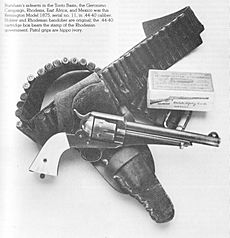
A scout named Holmes had a big influence on Burnham. Holmes had served with Kit Carson. He taught Burnham many scouting skills. These included how to track, how to hide his own trail, and how to find water in the desert. Burnham also learned how to survive in the wilderness. Holmes taught him that even simple things, like tying a knot, have a right way to be done. The two men earned a living by hunting and prospecting. Burnham also worked as a cowboy and a mine guard.
In Globe, Arizona, Burnham accidentally joined the losing side of the Pleasant Valley War. This was a violent conflict. He narrowly escaped death. He had no personal reason to be in the fight.
Burnham later went back to California for high school but did not graduate. He returned to Arizona and became a Deputy Sheriff. But he soon went back to herding cattle and prospecting. On February 6, 1884, he married his childhood sweetheart, Blanche Blick. He was 23. They settled in Pasadena, California, to tend an orange grove. But Burnham soon returned to prospecting and scouting. He was also active in Freemasonry.
By the 1880s, many felt the American West was no longer wild. Famous scouts like Buffalo Bill were becoming entertainers. The United States Census Bureau officially declared the American frontier closed in 1890. Burnham, who loved adventure, looked for new challenges. He heard about Cecil Rhodes's work in southern Africa. Rhodes was building a railway across Africa. In 1893, Burnham sold his belongings. He sailed to Durban in South Africa with his wife and young son. He planned to join Rhodes's pioneers in Matabeleland.
Military Adventures in Africa
First Matabele War
Burnham, his wife, and son traveled 1,000 miles north to Matabeleland. War broke out in late 1893 between Rhodes's British South Africa Company and the Matabele King Lobengula. Burnham immediately joined the company as a scout. Leander Starr Jameson, the company's leader, wanted to capture Lobengula. He sent Burnham and other scouts to Bulawayo, the king's town. They watched as the Matabele burned the town. By the time company troops arrived, Lobengula had fled. The company set up a base in Bulawayo. They sent patrols to find Lobengula. The most famous was the Shangani Patrol, led by Major Allan Wilson. Burnham was his Chief of Scouts.
The Shangani Patrol
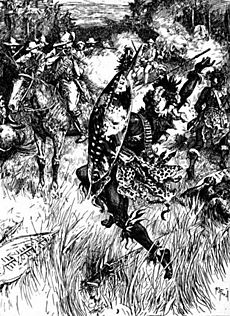
Jameson sent soldiers under Major Patrick Forbes to find Lobengula. On December 3, 1893, the soldiers camped near the Shangani River. The next day, Major Wilson and a dozen men crossed the river to patrol. They found Matabele women and children who claimed to know Lobengula's location. Burnham, the lead scout, suspected a trap. He advised Wilson to turn back, but Wilson ordered them to go forward.
Soon, the patrol found the king. Wilson sent a message for more soldiers. Forbes, however, would not cross the river in the dark. He sent only 20 more men to help Wilson. Forbes planned to send the main army the next morning. But the main group was attacked by Matabele warriors and delayed. Wilson's patrol was also attacked. The Shangani River had flooded, making retreat impossible. In a desperate move, Wilson sent Burnham and two other men, Pearl "Pete" Ingram and William Gooding, to cross the river and get help from Forbes.
Despite many bullets and spears, the three men reached Forbes. But the battle there was just as fierce. There was no hope of anyone reaching Wilson in time. Burnham told Forbes, "I think I may say that we are the sole survivors of that party." Wilson, Borrow, and their men were surrounded and all were killed.
This event became known as the Shangani Patrol. Wilson and Borrow were seen as national heroes. Their last stand became a famous story in Rhodesia. The story is based on accounts from Burnham, Ingram, Gooding, and Matabele witnesses. Some historians have debated if Burnham and the others were truly sent back or if they left on their own. However, all officers and soldiers in Forbes' group praised Burnham's actions. They never doubted his conduct. For his service, Burnham received the British South Africa Company Medal. He also got a gold watch and land. Matabeleland became part of Rhodesia in 1895.
Exploring Northern Rhodesia
In 1895, Burnham led an expedition for the British South Africa Company. They found large copper deposits north of the Zambezi in North-Eastern Rhodesia. Burnham noticed similarities to copper mines he knew in the United States. He also saw local people wearing copper bracelets. After this trip, he became a member of the Royal Geographical Society. Later, the British South Africa Company built mining towns and a railroad in this area, known as the Copperbelt.
Second Matabele War
In March 1896, the Matabele rebelled again. This was called the Second Matabele War. Mlimo, the Matabele spiritual leader, encouraged the uprising. The colonists' defenses were weak because of the Jameson Raid. Hundreds of white settlers were killed. With few troops, settlers built a camp in Bulawayo. They sent out patrols led by Burnham, Robert Baden-Powell, and Frederick Selous. The Matabele retreated into the Matopos Hills. This area became the site of fierce fighting. During this war, Burnham and Baden-Powell met. They discussed ideas for training young people, which later became Scouting.
Stopping the Mlimo
Burnham and Bonar Armstrong, a company official, found a sacred cave in the Matopos Hills. This was where Mlimo was hiding. Near the cave was a village with about 100 huts full of warriors. The two men tied their horses and crawled quietly toward the cave. They waited until Mlimo entered. Mlimo was described as about 60 years old with a cruel look. Burnham and Armstrong waited until Mlimo began his ritual dance. Then, Burnham shot and killed Mlimo.
Burnham and Armstrong quickly ran toward their horses. The warriors in the village began searching for the attackers. To distract them, Burnham set fire to some huts. The two men escaped and rode back to Bulawayo. Soon after, Cecil Rhodes walked unarmed into the Matabele stronghold. He made peace with the rebels, ending the Second Matabele War.
Klondike Gold Rush and Boer War
After the Matabele wars, Burnham decided to leave Africa. He returned to California. Soon after, he went to Alaska and the Yukon to search for gold in the Klondike Gold Rush. His eldest son, Roderick, who was 12, went with him. When he heard about the Spanish–American War, Burnham rushed home to volunteer. But the war ended before he could join.
Second Boer War
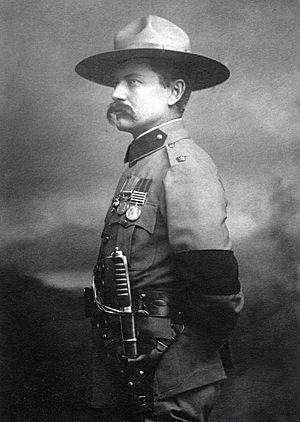
The Second Boer War (1899–1902) was fought between the British and two independent Boer republics. It was partly caused by a desire to control the rich Witwatersrand gold mines. Field Marshal Frederick Roberts, a successful British commander, was put in charge of British forces. Roberts asked General Frederick Carrington, who had commanded in Matabeleland, for advice. Carrington recommended Burnham as Chief of Scouts. He called Burnham "the finest scout who ever scouted in Africa."
Roberts sent for Burnham in January 1900. Burnham was prospecting in Alaska when he received the telegram. He left immediately for South Africa. Burnham was given a command post and the British Army rank of captain. This was unusual for a foreigner. He arrived just before the Battle of Paardeberg in February 1900. During the war, Burnham often went behind Boer lines. He gathered information and blew up railway bridges. He was captured twice but escaped both times. He was also seriously wounded once.
Burnham was first captured at Sanna's Post. He surrendered to get information on the enemy. He then escaped and reached British-held Bloemfontein after two days. The second time he was captured was while trying to warn a British column. He saw Boers hiding near a river. Burnham signaled the British soldiers to turn back, even though it meant he would be captured. The column ignored his warning and walked into the ambush. Burnham was taken prisoner. He pretended to be wounded and was placed in a wagon with other injured officers. Later that night, he slipped out of the wagon and rolled into a ditch. He lay motionless until the wagon passed over him. It took him four days to return to British lines. He had very little food or water.
On June 2, 1900, Burnham was badly wounded during the British march on Pretoria. He was trying to stop Boer gold and supplies from reaching the sea. He was also trying to prevent British prisoners from leaving Pretoria. He scouted alone behind enemy lines. He found a railway bridge underpass, a perfect spot to disrupt trains. But he was surrounded by Boers. Burnham fled, but his horse was shot and fell, pinning him. It was night, and the Boers did not check if he was injured. When he woke hours later, he was alone and hurt. Despite his pain, Burnham crawled back to the railway. He placed explosives and blew up the line in two places. He then crawled to an empty animal pen and stayed there for two days. He was found by a British patrol. He survived because he had been without food or water for three days.
Burnham's injuries were so severe that Lord Roberts ordered him to England. Two days before leaving, he was promoted to major. He received praise from Baden-Powell, Rhodes, and Roberts. In England, he was invited to dine with Queen Victoria. After the Queen's death, King Edward VII personally gave Burnham the Queen's South Africa Medal. He also received the Distinguished Service Order, the second highest British Army award. The King made his British Army rank permanent, even though he was American. Burnham received the highest awards of any American in the Second Boer War. The British press called him "The King of Army Scouts."
"Father of Scouting"
Burnham was already a famous scout when he met Baden-Powell during the Second Matabele War. Their backgrounds were very different. Burnham grew up on the plains. His friends were Sioux Indian boys. He learned about tracking and outdoor skills from an early age. He supported himself by hunting and riding for Western Union. His mentors were experienced scouts from the American West. By 19, he was a skilled scout, chasing Apache. Baden-Powell was born in London and went to a famous English school. He joined the British Army at 19. He had written a book called Reconnaissance and Scouting (1884).
When they met in 1896, Baden-Powell was an army intelligence officer. Burnham was General Carrington's Chief of Scouts. During the siege of Bulawayo, they often patrolled the Matopos Hills together. Burnham taught Baden-Powell "woodcraft," now known as Scoutcraft. Baden-Powell had written about tracking, but Burnham taught him new skills. These included traveling without a compass or map, observing animals for danger, and finding water. Baden-Powell was very impressed by Burnham's scouting spirit. He began to wear a Stetson campaign hat and neckerchief, like Burnham's. Both men realized that armies needed to adapt. They discussed a training program for young men. It would focus on exploration, tracking, fieldcraft, and self-reliance.
In his first scouting handbook, Aids to Scouting (1899), Baden-Powell included many lessons from Burnham. This book was later used by boys' groups. Baden-Powell then decided to adapt his book specifically for boys. He published Scouting for Boys (1908) and founded the international Scouting movement. Burnham has been called the movement's father. James E. West, Chief Scout Executive for the Boy Scouts of America (BSA), said that Burnham inspired Baden-Powell. He noted that these two pioneers met in Africa years before Scouting was even thought of.
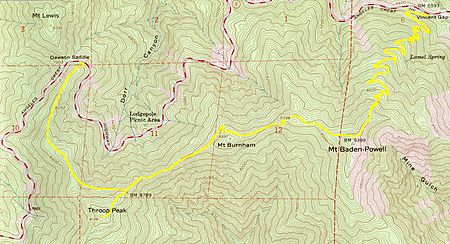
Burnham became good friends with other Scouting leaders in the United States. These included Theodore Roosevelt and Gifford Pinchot. E. B. DeGroot, a BSA Scout Executive, said Burnham was the "heroic figure" who inspired Baden-Powell's plan for Scouting. With Baden-Powell's help, the BSA published Burnham's biography: He-who-sees-in-the-dark; the Boys' Story of Frederick Burnham, the American Scout. The BSA made Burnham an Honorary Scout in 1927. In 1936, he received the Silver Buffalo Award, the BSA's highest honor. He remained active in Scouting until his death.
Burnham and Baden-Powell stayed close friends throughout their lives. Burnham called Baden-Powell a "wonderfully able scout" and nicknamed him "Sherlock Holmes." Baden-Powell thought Burnham was "the greatest scout alive." In 1931, Burnham spoke at the dedication of Mount Baden-Powell in California. Their friendship was honored in 1951 when the nearby peak was named Mount Burnham.
Burnham's family members also became involved in Scouting and the military. His son Roderick fought in France in World War I. His great-grandson, Russell Adam Burnham, is an Eagle Scout. He was the United States Army's Soldier of the Year in 2003.
Later Life and Work
After the War
After recovering from his injuries, Burnham became a manager in London for the Wa Syndicate. This company had interests in West Africa. In 1901, he led an expedition through the Gold Coast and Upper Volta. He searched for minerals and ways to improve river travel. From 1902 to 1904, he led a large mineral prospecting trip in the East Africa Protectorate (Kenya). He traveled around Lake Rudolf (now Lake Turkana) and found a huge soda lake.
Mexican Projects
Burnham returned to North America. For several years, he worked on an irrigation project in Mexico's Yaqui River valley. He believed a dam could provide water for farming and generate electricity. He bought water rights and land in the area. He then contacted his old friend, John Hays Hammond, who bought even more land. Burnham and Charles Frederick Holder also made important archaeological discoveries of Mayan ruins, including the Esperanza Stone.
In 1909, U.S. President William Howard Taft and Mexican President Porfirio Díaz planned a meeting. This was the first time a U.S. president would cross into Mexico. Tensions were high, and there were threats of assassination. Many security forces were called in. Burnham was in charge of a private security team of 250 men. On October 16, the day of the meeting, Burnham and a Texas Ranger found a man with a hidden gun. They captured the man just feet from Taft and Díaz.
After this, Burnham led 500 men guarding mining properties in Mexico. These properties belonged to Hammond, J. P. Morgan, and the Guggenheims. In 1912, a series of Mexican revolutions began. In 1917, Mexico passed laws preventing foreigners from owning land. Burnham and Hammond eventually sold their properties to the Mexican government in 1930.
World War I Efforts
During this time, Burnham was one of 18 officers chosen by former U.S. President Theodore Roosevelt. They planned to raise a volunteer infantry division for service in France in 1917. Burnham was in charge of organizing and recruiting. However, President Woodrow Wilson refused to use Roosevelt's volunteers. Wilson was a political rival of Roosevelt. Wilson announced he would send an American Expeditionary Force under General John Pershing instead. Roosevelt had to disband his volunteers.
During World War I, Burnham lived in California. He worked in counterespionage for Britain. This involved a famous Boer spy named Captain Fritz Joubert Duquesne. Duquesne became a German spy in both World Wars. Burnham and Duquesne had been ordered to assassinate each other during the Second Boer War. They later met in 1910 while both were trying to get a bill passed to import African animals into the U.S.
Oil Success
Burnham had traveled the world but had not become wealthy. This changed when he returned to California. In November 1923, he discovered oil in Dominguez Hills, near Carson, California. Over 150 wells soon produced thousands of barrels of oil daily. The Burnham Exploration Company, formed by Frederick Burnham, his son Roderick, and John Hayes Hammond, received a large share. In its first 10 years, the company paid out over $10 million in dividends. The land where Burnham found oil was where he used to graze cattle as a boy. This was how he supported his widowed mother and infant brother.
Protecting Nature
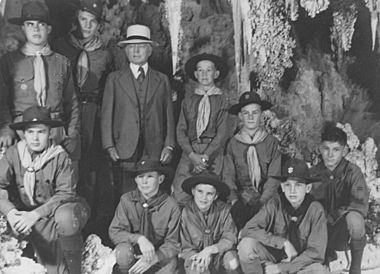
Burnham was a strong conservationist and hunter. He supported the early conservation programs of his friends Theodore Roosevelt and Gifford Pinchot. He and John Hayes Hammond led trips to Africa to find large animals. They hoped to breed these animals in the United States for future sportsmen. In 1914, he helped create the Wild Life Protective League of America.
In his later years, Burnham held several public roles. He was a member of the Boone and Crockett Club. He was also a founding member of the American Committee for International Wildlife Protection. He was one of the first members of the California State Parks Commission (1927–1934). He helped found the Save the Redwoods League. He was president of the Southwest Museum of the American Indian from 1938 to 1940. He also served as Honorary President of the Arizona Boy Scouts. He was a regional executive for the BSA until his death in 1947.
In 1936, Burnham asked the Arizona Boy Scouts to help save the Desert Bighorn Sheep. These animals were close to extinction. Other groups joined the effort. A "save the bighorns" poster contest was held in schools. Burnham provided prizes and appeared in store windows. The winning bighorn emblem was made into neckerchief slides for 10,000 Boy Scouts. Talks and plays were given at schools and on the radio. On January 18, 1939, over 1.5 million acres were set aside in Arizona. This created the Kofa National Wildlife Refuge and the Cabeza Prieta National Wildlife Refuge. Burnham gave the dedication speech.
Personal Life
Burnham was short, about 5 feet 4 inches tall. But he was muscular and tanned. He had a boyish look that he used to his advantage. His most striking feature was his steady, grey-blue eyes. People said his gaze never left the person he was looking at. Yet, he could also see everything around him. His eyes also had a far-away look, like someone who constantly watches the sea or vast plains.
Burnham trained himself to be patient. He took short naps instead of long sleeps. He drank very little liquid. He trained himself to endure fatigue, hunger, thirst, and wounds. This helped him survive in harsh environments. He was quiet and polite. People described him as modest and rarely spoke of his many adventures.
Burnham died of heart failure on September 1, 1947, at age 86. He was at his home in Santa Barbara, California. He was buried in a private ceremony at Three Rivers, California. This was near his old cattle ranch. His memorial stone was designed by his only surviving child, Roderick. His first wife, Blanche, is also buried there. Several members of the Blick family, who pioneered Rhodesia with Burnham, are also buried there. "Pete" Ingram, the Montana cowboy who survived the Shangani Patrol with Burnham, is also buried there.
Family Life
Burnham's wife of 55 years, Blanche (1862–1939), traveled with him in difficult conditions. They went through the Southwest United States and southern Africa. They had three children, who spent their early years in Africa. Blanche watched over the children and animals. She always kept a rifle nearby. She used it many times against lions and hyenas. During the Siege of Bulawayo, she used it against Matabele warriors. Several members of Blanche's family joined the Burnhams in Rhodesia. They later moved to England and then returned to California. When the Burnham Exploration Company became wealthy in 1923, the Burnhams moved to a mansion in Hollywoodland. They traveled the world in style. In 1939, Blanche had a stroke and died a month later. She was buried in the Three Rivers Cemetery.
Burnham's first son, Roderick (1886–1976), was born in Pasadena, California. He went with his family to Africa and learned the Matabele language. He went to boarding school in France and military school in England. In 1898, he went to Alaska with his father. He later attended the University of California, Berkeley and the University of Arizona. He played football and became a team captain. He studied geology and worked for Union Oil. He helped develop oil wells in Mexico and Venezuela. He served in the U.S. Army in World War I. He and his father were minority owners of the Burnham Exploration Company. In 1930, he started the first airline in Guatemala.
Nada (1894–1896), Burnham's daughter, was the first white child born in Bulawayo. She died of fever and starvation during the town's siege. She was buried in the Pioneer Cemetery. Nada is the Zulu word for lily. She was named after a character in a book by H. Rider Haggard. Three of Haggard's books are dedicated to her.
Burnham's youngest son, Bruce B. Burnham (1897–1905), accidentally drowned in the River Thames in London. His brother, Roderick, was in California but claimed to know what happened from a dream.
His brother Howard Burnham (1870–1918) lost one leg at age 14. He suffered from tuberculosis. He lived with Fred in California and learned scouting skills from him. Howard moved to Africa and became a mining engineer. He wrote a textbook on mine valuation. He traveled the world and worked with Fred on the Yaqui River project in Mexico. During World War I, Howard worked as a spy for the French government. He operated behind enemy lines in Germany. He used his wooden leg to hide spying tools. Before he died, he shared important information with the French government. He was buried in Cannes, France.
Burnham's first cousin Charles Edward Russell (1860–1941) was a journalist and politician. He also helped found the National Association for the Advancement of Colored People (NAACP). He won a Pulitzer Prize in 1928 for a biography.
In 1943, at 83, Burnham married his typist, Ilo K. Willits Burnham (1894–1982). They sold their mansion and moved to Santa Barbara in 1946.
Burnham was a descendant of Thomas Burnham (1617–1688) of Hartford, Connecticut. His family has been noted in every American war.
Film and Stage Stories
In 1899, Frank E. Fillis brought his show "Savage South Africa" to London. It featured Zulu performers and re-enacted famous battles from the Matabele wars. The show included "Wilson's Heroic Stand at the Shangani River." Fillis played Major Wilson, and Burnham was played by "Texas Jack" Jr.. This part of the show was filmed in September 1899 and sold as Major Wilson's Last Stand. Years later, a full-length film, Shangani Patrol (film) (1970), was made. Burnham was played by American actor Will Hutchins.
In 1958, Ernest Hemingway bought the rights to make a film of Burnham's memoirs, Scouting on Two Continents. CBS hired Hemingway to produce it for television. Gary Cooper was interested in playing Burnham. However, Hemingway died in 1961 before work began.
Another film, On My Honor, was started by Cecil B. DeMille. It was meant to show the founding of the Scouting movement. But it was unfinished when DeMille died in 1959. The script focused on Baden-Powell, Burnham, and other Scouting pioneers.
In 2014, RatPac Entertainment and Class 5 Films acquired the rights to an article called "American Hippopotamus." It was about a meat shortage in the U.S. in 1910. It also covered attempts by Burnham, Duquesne, and Congressman Robert Broussard to bring hippos to Louisiana. The movie will highlight the rivalry between Burnham and Duquesne.
Tributes and Honors
Sir H. Rider Haggard, a famous author, was greatly influenced by Burnham's adventures. Haggard's fictional hero, Allan Quatermain, has many similarities to Burnham. Both explored Africa, found ancient treasures, and battled wild animals. Both were known for their tracking skills. Quatermain was called "Watcher-by-Night," and Burnham was called "He-who-sees-in-the-dark."
To celebrate 100 years of Scouting, the BSA issued 100 bronze coins in 2007. One side shows Burnham and is inscribed: "Major Frederick Russell Burnham," "Father of Scouting." The other side shows Baden-Powell and is inscribed: "Col. Robert Baden-Powell," "Founder of Scouting." The BSA also helped create the Major Burnham Bowling Trophy. Serbelodon burnhami, an extinct elephant-like animal from California, was named after Burnham. It was discovered by John C. Blick, his first wife's brother.
Images for kids
See also
 In Spanish: Frederick Russell Burnham para niños
In Spanish: Frederick Russell Burnham para niños


